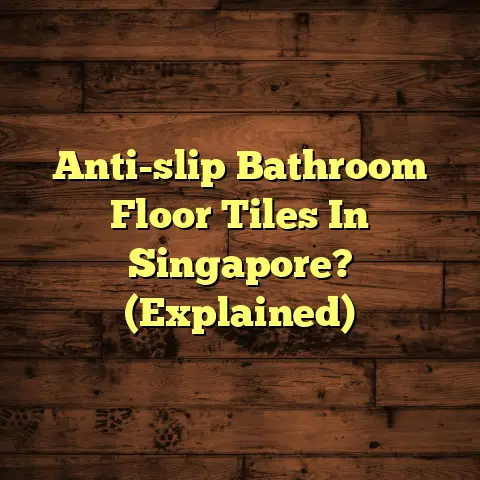Remove Nail Glue From Floors: Help! (2 Steps!)
“Success is the sum of small efforts, repeated day in and day out.” – Robert Collier
Ever been there?
You’re giving yourself a mani-pedi, feeling all relaxed, and BAM!
A rogue drop of nail glue lands smack-dab on your gorgeous hardwood floor.
Ugh, the panic!
I’ve been there, and let me tell you, it’s not a fun feeling.
But don’t worry! It’s crucial to tackle it fast to avoid long-term damage.
That’s why I’m going to walk you through a simple, yet effective, two-step process to get that sticky situation sorted out.
Trust me, you can do this!
Section 1: Understanding Nail Glue and Its Impact on Flooring
1. What is Nail Glue?
Nail glue, also known as cyanoacrylate adhesive, is a fast-drying, super-strong adhesive.
We use it all the time to attach artificial nails, repair broken nails, or even for some crafty projects.
But here’s the thing: its chemical composition is designed for a super-strong bond, which is great for nails but not so great when it ends up where it shouldn’t.
The main ingredient, cyanoacrylate, reacts with moisture in the air to form a long, strong polymer chain.
That’s what makes it stick so well.
2. Types of Flooring
Now, let’s talk about your floor.
Different flooring types react differently to nail glue.
Hardwood: This is a classic and beautiful choice, but it’s also porous.
Nail glue can seep into the wood grain, causing staining and damage to the finish.
* Laminate: Laminate is more resistant to staining than hardwood, but the glue can still damage the surface layer and leave a visible mark.
* Tile: Tile is generally pretty resilient.However, nail glue can still be a pain to remove from the grout lines and can even leave a residue on the tile surface.
* Vinyl: Vinyl is relatively non-porous, making it easier to clean.But, harsh chemicals can discolor or damage the vinyl, so you need to be careful.
* Carpet: Oh, carpet… This can be the trickiest one.Nail glue can bond to the fibers, making it super hard to remove without damaging the carpet.
3. Potential Damage
If you leave nail glue on your floor, it can lead to a whole host of problems.
- Discoloration: The glue itself can discolor over time, and it can also trap dirt and grime, making the area look even worse.
- Staining: As I mentioned, the glue can seep into porous materials like hardwood and carpet, causing permanent stains.
- Surface Damage: Trying to scrape off the glue without the right technique can easily scratch or damage the surface of your floor.
Let me share a quick story: I had a client, Sarah, who accidentally spilled nail glue on her brand-new engineered hardwood floor.
She panicked and tried to scrape it off with a butter knife (I know, right?!).
Needless to say, she ended up with a scratched floor and a bigger mess than she started with.
That’s why it’s so important to address the issue correctly and quickly.
Section 2: Step 1 – Initial Cleanup
Alright, let’s get down to business.
The first step is all about getting the bulk of that glue off your floor without causing any further damage.
1. Gathering Supplies
First things first, you need to gather your supplies. Here’s what I recommend:
-
Safety Gear:
- Gloves: Protect your hands from the chemicals.
- Eye Protection: Just in case of any splashes.
-
Cleaning Agents:
-
Acetone (Nail Polish Remover): This is often the first thing people reach for, and it can work, but use it cautiously.
- Rubbing Alcohol (Isopropyl Alcohol): A gentler alternative to acetone.
- Goo Gone: This is a commercial adhesive remover that’s specifically designed for sticky situations.
-
Cloths:
-
Soft Microfiber Cloths: For gently wiping and dabbing.
- Paper Towels: For blotting up excess liquid.
-
Scrapers:
-
Plastic Putty Knife: This is great for gently lifting the glue without scratching the floor.
- Old Credit Card or Gift Card: These work well for scraping, too.
-
Other:
-
Warm Water: For rinsing.
- Mild Dish Soap: For cleaning up afterward.
- Cotton Swabs: For getting into small crevices.
I personally like using Goo Gone for most situations because it’s effective and generally safe for most floor types.
But always test in an inconspicuous area first!
2. Preparing the Area
Before you start slinging chemicals around, it’s important to prep the area.
- Move Furniture: Get anything that’s in the way out of the way.
- Protect Adjacent Surfaces: Cover any nearby carpets or delicate surfaces with a drop cloth or plastic sheeting.
Ventilation: Open a window or turn on a fan to ensure good ventilation.
You don’t want to be breathing in those fumes!
* Safety First: Keep kids and pets away from the area while you’re working.
3. Applying the Cleaning Solution
Okay, now for the fun part (sort of).
Here’s the step-by-step:
Test, Test, Test: Before you slather any cleaning solution all over the glue, test it on a small, inconspicuous area of your floor.
This is crucial to make sure it doesn’t damage or discolor the surface.
Wait at least 30 minutes after applying the solution to see if there’s any reaction.
2.
Dampen a Cloth: Once you’ve confirmed that the solution is safe, dampen a clean microfiber cloth with your chosen cleaning agent.Don’t soak it!
You want it damp, not dripping.
3.
Apply to the Glue: Gently dab the cloth onto the nail glue.Let it sit for a few minutes to soften the glue.
The amount of time will depend on the type of glue and the type of flooring.
Start with 2-3 minutes and check frequently.
4.
Patience is Key: Don’t rush this process!
The goal is to soften the glue, not dissolve it instantly.Applying too much pressure or using harsh scrubbing motions can damage your floor.
4. Removing the Glue
Alright, the glue should be softened now.
Let’s get it off!
Gentle Scraping: Using your plastic putty knife or old credit card, gently scrape at the edges of the glue.
Work slowly and carefully, applying even pressure.
The glue should start to lift away from the floor.
2.
Recognizing the Breakdown: As you scrape, you’ll notice the glue starting to break down and become more pliable.This is a good sign!
Keep working at it gently until you’ve removed as much of the glue as possible.
3.
Stubborn Glue: If the glue is particularly stubborn, reapply the cleaning solution and let it sit for a few more minutes.You can also try using a cotton swab soaked in the solution to target small, hard-to-reach areas.
4.
Troubleshooting:- If the glue is still hard: You may need to try a different cleaning solution or let it sit for a longer period.
- If the floor is starting to look damaged: Stop immediately and consult a professional flooring contractor.
I remember one time, I was helping a friend remove nail glue from her laminate floor.
We tried everything, but the glue just wouldn’t budge.
Finally, we decided to try using a hairdryer to gently heat the glue, and that did the trick!
The heat softened the glue just enough for us to scrape it off without damaging the floor.
Section 3: Step 2 – Final Touches and Maintenance
Congratulations! You’ve successfully removed the bulk of the nail glue.
Now, let’s take care of those final touches to make sure your floor looks as good as new.
1. Cleaning the Area Post-Removal
Even after you’ve removed the glue, there may still be some residue left behind.
Here’s how to clean it up:
- Warm Water Rinse: Dampen a clean microfiber cloth with warm water and gently wipe the area to remove any remaining cleaning solution.
- Mild Soap Solution: In a bucket, mix a small amount of mild dish soap with warm water.
- Gentle Cleaning: Dip a clean cloth into the soapy water and gently wipe the area again.
- Final Rinse: Rinse the area one last time with clean water to remove any soap residue.
-
Dry Thoroughly: Use a clean, dry cloth to dry the area completely.
This is especially important for hardwood floors to prevent water damage.
2. Repairing Any Damage
Now, take a good look at your floor.
Did the glue removal process cause any damage?
Here are a few common issues and how to address them:
Scratches on Hardwood: If you have minor scratches, you can try using a wood touch-up marker or a scratch repair kit.
For deeper scratches, you may need to sand and refinish the area.
* Damaged Laminate: Unfortunately, laminate is difficult to repair.If the damage is significant, you may need to replace the affected plank.
* Stains on Tile Grout: Use a grout cleaner and a scrub brush to remove any stains.For stubborn stains, you can try using a bleach pen, but be careful not to get it on the tile itself.
* Discoloration on Vinyl: Try using a vinyl floor cleaner to remove any discoloration.If that doesn’t work, you may need to replace the affected area.
* Damaged Carpet Fibers: Use scissors to carefully trim away any damaged fibers.You can also try using a carpet stain remover to lift any remaining residue.
I once had a client who had scratched their hardwood floor while trying to remove nail glue.
I recommended they use a wood stain pen that closely matched the color of their floor.
It worked like a charm, and you couldn’t even tell there had been a scratch there!
3. Preventative Measures for the Future
Okay, so you’ve learned your lesson, right?
Let’s make sure this doesn’t happen again!
Here are some tips to prevent future nail glue spills:
Designated Nail Area: Create a designated area for your manicures and pedicures.
Cover the area with a protective mat or towel to catch any spills.
* Careful Application: Be extra careful when applying nail glue.Use a small amount and avoid squeezing the bottle too hard.
* Proper Storage: Store your nail glue in a safe place, away from heat and direct sunlight.Make sure the cap is tightly closed to prevent leaks.
* Protective Coverings: Consider using a nail art mat or a silicone mat to protect your surfaces while you’re working.
Let me tell you, investing in a good quality nail art mat is one of the best things I ever did.
It’s saved my table from countless spills and messes!
Conclusion
So, there you have it!
Removing nail glue from your floors doesn’t have to be a nightmare.
By following these two simple steps, you can tackle the issue quickly and effectively, without causing any further damage to your beautiful floors.
Remember, a little bit of patience and the right tools can go a long way.
Taking care of your home is an ongoing process, but it’s also incredibly rewarding.
There’s nothing quite like the satisfaction of solving a problem and restoring your home to its former glory.
Call to Action
Now, I’d love to hear from you!
Have you ever had a nail glue mishap?
What are your go-to methods for removing sticky substances from your floors?
Share your experiences and tips in the comments below!
Let’s learn from each other and build a supportive community of DIY home enthusiasts.





